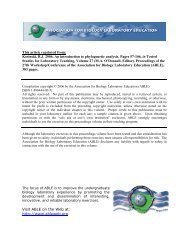A Study of Gene Linkage and Mapping Using - Association for ...
A Study of Gene Linkage and Mapping Using - Association for ...
A Study of Gene Linkage and Mapping Using - Association for ...
Create successful ePaper yourself
Turn your PDF publications into a flip-book with our unique Google optimized e-Paper software.
14 Tetrad Analysis<br />
4. Now, remove 10 to 15 perithecia by scraping the loop’s tip back <strong>and</strong> <strong>for</strong>th over the surface <strong>of</strong><br />
the agar. Do not dig into the agar.<br />
5. Place the perithecia into the drop on the slide <strong>and</strong> uni<strong>for</strong>mly distribute the perithecia throughout<br />
the drop. Place a cover slip over the perithecia <strong>and</strong> water.<br />
6. Place a kimwipe over your finger (to avoid putting a fingerprint on the cover slip) <strong>and</strong> push<br />
down gently, but a little firmly, on the cover slip. If you rub the cover slip back <strong>and</strong> <strong>for</strong>th (very<br />
slightly) over the slide, you will spread the asci better.<br />
7. View the slide with the compound microscope first with the 10X objective in place.<br />
8. Select <strong>for</strong> study only those perithecia that contain asci with more than one spore phenotype.<br />
Identify the phenotypes <strong>of</strong> the spores in each ascus with the 40X objective in place. Figure 1.6<br />
shows two properly squashed perithecia.<br />
Figure 1.6. Photomicrograph <strong>of</strong> Sordaria fimicola showing two well-spread perithecia suitable <strong>for</strong><br />
tetrad analysis.<br />
Data Collection<br />
Properly squashed perithecia will eject their asci in a radial arrangement, like the spokes <strong>of</strong> a<br />
wheel. In collecting data it is best to start at one point, systematically moving in a clockwise or<br />
counterclockwise fashion, categorizing each ascus that can be clearly seen until a full circle has<br />
been completed. You will need to focus carefully to see all the spores in an ascus. Note that the<br />
ascus narrows on the end that connects it to the fungal mycelium. Locating the narrowed, broken<br />
end will allow you to properly classify any isolated asci that may be found on your slides.<br />
1. To be most successful at identifying spore phenotypes as you use the microscope to examine<br />
perithecial squashes be sure to:<br />
(a) keep light intensity low so you can see color differences better,<br />
(b) focus up <strong>and</strong> down carefully to see all eight ascospores,<br />
(c) avoid immature asci (their spores will have a granular appearance <strong>and</strong> very little color), <strong>and</strong><br />
(d) seek your instructor’s help until you become confident in your ability to identify the phenotypes.<br />
2. As you classify asci, write down in abbreviated <strong>for</strong>m the sequence <strong>of</strong> spores within each ascus.<br />
For example, the ascus in Figure 1.4E could be represented as CCBBGGTT (from left to right)
















